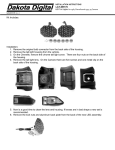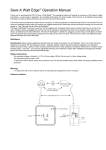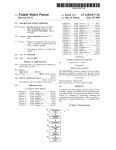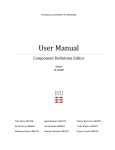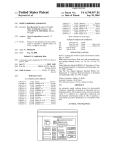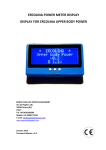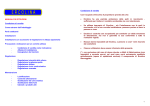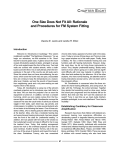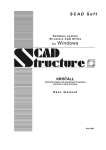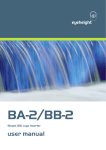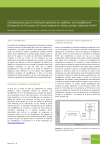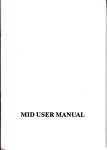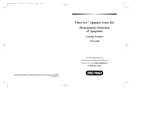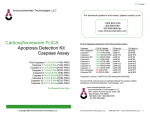Download BD ApoAlert DNA Fragmentation Assay Kit
Transcript
BD ApoAlert™ DNA Fragmentation Assay Kit User Manual Cat. Nos.630107 630108 PT3137-1 (PR4Y988) Published 17 November 2004 BD ApoAlert™ DNA Fragmentation Assay Kit User Manual Table of Contents I. Introduction 3 II. List of Components 6 III. Additional Materials Required 7 IV. Controls 9 V. Sample Preparation for Microscopic Detection 10 A. Adherent Cells 10 B. Suspended Cell Cultures 11 C. Tissue Sections 12 VI. Detection by Microscopy 14 VII. Detection by Flow Cytometry 16 VIII. Troubleshooting Guide 18 IX. References 19 X. Related Products 20 Notice to Purchaser This product is intended to be used for research purposes only. It is not to be used for drug or diagnostic purposes nor is it intended for human use. BD Biosciences – Clontech products may not be resold, modified for resale, or used to manufacture commercial products without written approval of BD Biosciences – Clontech. Triton™ is a trademark of The Dow Chemical Company. BD, BD Logo and all other trademarks are property of Becton, Dickinson and Company. ©2004 BD BD Biosciences – Clontech 2 www.bdbiosciences.com Protocol No. PT3137-1 Version No. PR4Y988 BD ApoAlert™ DNA Fragmentation Assay Kit User Manual I. Introduction Apoptosis, or programmed cell death, plays a fundamental role in many normal biological processes, as well as in several disease states (Wyllie et al., 1980; Ellis et al., 1991; Cohen et al., 1992; Thompson, 1995; Nicholson, 1996). Apoptotic cells undergo many distinct morphological and biochemical changes, including fragmentation of nuclear DNA (Schwartzman & Cidlowski, 1993; Walker et al., 1991; Oberhammer et al., 1993; Roy et al., 1992). During apoptosis, cellular endonucleases cleave nuclear DNA between nucleosomes, producing a mixture of DNA fragments whose lengths vary in multiples of 180 to 200 bp. The BD ApoAlert™ DNA Fragmentation Assay Kit detects apoptosis-induced nuclear DNA fragmentation via a fluorescence assay. The assay is based on terminal deoxynucleotidyl transferase (TdT)-mediated dUTP nick-end-labeling (TUNEL; Gavrieli et al., 1992; Piqueras et al., 1996; Facchinetti et al., 1991; Wijsman et al., 1993). TdT catalyzes incorporation of fluorescein-dUTP at the free 3'-hydroxyl ends of fragmented DNA; fluorescein-labeled DNA can be detected via fluorescence microscopy or flow cytometry. This kit uses a direct labeling procedure for detecting DNA fragmentation at the single-cell level. With a fluorescence microscope equipped with FITC filters, you can visualize areas of apoptotic cells in situ in tissue sections. The kit can be used with adherent cells and cells in suspension. Other BD ApoAlert™ Apoptosis Detection Kits Although the TUNEL assay is widely used for detecting apoptosis, DNA fragmentation occurs relatively late in the process. Recent studies have elucidated some molecular events that are characteristic of the early stages of apoptosis (Zhang, et al., 1996; Koester, et al., 1997; Green, 1998; Nicholson & Thornberry, 1997; Thornberry & Littlewood, 1998). As a result, the TUNEL assay can be complemented with other assays that detect apoptosis at earlier stages. • The BD ApoAlert™ Caspase-3 Fluorescent Assay Kits (Cat. Nos. 630214 & 630215) and BD ApoAlert™ Caspase-3 Colorimetric Assay Kits (Cat. Nos. 630216 & 630217) provide assays for caspase-3 protease activity, or other proteases that recognize the caspase-3 cleavage sequence, DEVD. Induction of caspase-3 activity is one of the earliest events in Fas receptor-induced apoptosis; however, caspase-3 activity is induced somewhat later in staurosporine-induced apoptosis. • The BD ApoAlert™ Caspase-8 Fluorescent Assay Kits (Cat. Nos. 630218 & 630219) and BD ApoAlert™ Caspase-8 Colorimetric Assay Kits (Cat. Nos. 630220 & 630221) provide assays for caspase-8 protease activity. Induction of caspase-8 is one of the earliest events in Fas receptorinduced apoptosis. Note that staurosporine does not induce caspase-8. Protocol No. PT3137-1 Version No. PR4Y988 www.bdbiosciences.com BD Biosciences – Clontech 3 BD ApoAlert™ DNA Fragmentation Assay Kit User Manual I. Introduction continued • The BD ApoAlert™ Annexin V Apoptosis Kits (FITC: [Cat. Nos. 630109 & 630110]; EGFP: [Cat. No. 630113] are based on externalization of phosphatidylserine (PS) from the inner to the outer leaflet of the plasma membrane. This event occurs shortly after caspase activation. Annexin V is a protein with strong affinity for PS. The assay is simple and can be used with fluorescence microscopy or flow cytometry. • The BD ApoAlert™ Mitochondrial Membrane Sensor Kit (Cat. No. 630106) contains MitoSensor™, a reagent that detects changes in mitochondrial membrane potential that occur during apoptosis. The assay is simple and can be used with fluorescence microscopy or flow cytometry. • The BD ApoAlert™ Cell Fractionation Kit (Cat. No. 630105) provides a method for isolating a mitochondria-enriched fraction from the cytoplasm of apototic and non-apototic cells. It includes two different antibodies against Cytochrome C. The first antibody is used to identify the mitochondriaenriched fraction. The second antibody is used to determine if Cytochrome C has been released from the mitochondria and is present in the cytosolic fraction—an indicator of mitochondrial involvement in apotosis. • The BD ApoAlert™ Caspase-3 Assay Plate (Cat. Nos. 630223 & 630224) is a 96-well plate with the fluorogenic substrate of caspase-3 immobilized in the wells. When cell lysate containing active caspase-3 is placed in the wells, caspase-3 cleaves the substrate, releasing a fluorescent product that can be detected with a standard absorbance microplate reader. • The BD ApoAlert™ Caspase Profiling Plate (Cat. Nos. 630225 & 630226) is a 96-well plate with fluorogenic substrates for four different caspases immobilized in separate wells. When cell lysate containing the active caspase of interest is added to the wells, the caspase cleaves the substrate, yielding a fluorescent product that can be detected with a standard fluorescence microplate reader. • The BD ApoAlert™ pCaspase3-Sensor Vector (Cat. No. 630222) encodes a fusion of BD Living Colors™ Enhanced Yellow Fluorescent Protein (EYFP) and the nuclear localization signal (NLS) of SV40 T- antigen. It can be used to detect the onset of caspase-3 activity in mammalian cells with fluorescence microscopy. BD Biosciences – Clontech 4 www.bdbiosciences.com Protocol No. PT3137-1 Version No. PR4Y988 BD ApoAlert™ DNA Fragmentation Assay Kit User Manual I. Introduction continued • The BD ApoAlert™ pDsRed2-Bid Vector (Cat. No. 632419) encodes a fusion of a BD Living Colors™ Fluorescent Protein (DsRed2), a red fluorescent protein, and Bid, a member of the Bcl-2 family. In healthy, nonapototic cells, Bid resides in the cytosol as soluble protein. Upon induction of apotosis, Bid trafficks to the mitochondria. In cells expressing the BidDsRed fusion, Bid trafficking can be detected by fluorescence microscopy. • The BD ApoAlert™ pd4EGFP-Bid Vector (Cat. No. 630116) encodes a fusion of a BD Living Colors™ Fluorescent Protein (dEGFP), a destablilized enhanced green fluorescent protein, and Bid, a member of the Bcl-2 family. In healthy, non-apototic cells, Bid resides in the cytosol as soluble protein. Upon induction of apotosis, Bid trafficks to the mitochondria. In cells expressing the Bid-d4EGFP fusion, Bid trafficking can be detected by fluorescence microscopy. BD Biosciences – Clontech also offers apoptosis-inducing reagents as well as antibodies, protease inhibitors, stains, and other reagents for apoptosis research (see Related Products, Section IX). Protocol No. PT3137-1 Version No. PR4Y988 www.bdbiosciences.com BD Biosciences – Clontech 5 BD ApoAlert™ DNA Fragmentation Assay Kit User Manual II. List of Components Upon receipt, store the kit at –20°C. After first use, store 20X SSC and plastic coverslips at room temperature. Store all other components at –20°C. Important: The nucleotide mix is sensitive to light. • • • • • • Equilibration Buffer Nucleotide Mix TdT Terminal Transferase 20X SSC (see note below) Proteinase K (10 mg/ml) Plastic Coverslips Cat. No. 630107 (25 assays) 4 x 1 ml 2 x 62.5 µl 2 x 312.5 units 29 ml 440 µl 25 Cat. No. 630108 (100 assays) 10 x 1.6 ml 8 x 62.5 µl 5 x 500 units 116 ml 1.85 ml 100 Composition of components • Equilibration Buffer 200 25 0.2 0.25 2.5 mM mM mM mg/ml mM Potassium cacodylate (pH 6.6 at 25°C) Tris-HCl (pH 6.6 at 25°C) DTT BSA Cobalt chloride Potassium cacodylate (dimethylarsinic acid) is a mild irritant. Avoid skin and eye contact by wearing gloves and safety glasses. • 20X SSC 3 M 300 mM NaCl Na3Citrate•H2O If stored at –20°C, 20X SSC must be warmed to room temperature to ensure that all salts are in solution prior to 10X dilution with deionized H2O. After opening the kit, 20X SSC can be stored at room temperature. BD Biosciences – Clontech 6 www.bdbiosciences.com Protocol No. PT3137-1 Version No. PR4Y988 BD ApoAlert™ DNA Fragmentation Assay Kit User Manual III. Additional Materials Required For working with cell cultures (Sections V.A & V.B) • Poly-L-lysine coated microscope slides Apply 50–100 µl of a 0.1% (w/v) aqueous solution of poly-L-lysine (Sigma Cat. No. P8920) to the surface of sterile glass microscope slide. Spread evenly over the portion of the slide that will be used for growing and fixing cells. Airdry the slides for 1 hr and store at 4°C for up to one week. Alternatively, use Lab-Tek Chamber Slides or equivalent commercial slides. • Coplin jars filled with: • Phosphate-buffered saline (PBS [pH 7.4]; 6 jars) • 4% Formaldehyde/PBS (pH 7.4; 1 jar) Prepare formaldehyde/PBS solutions immediately before use. Combine 70 ml of PBS and 25 ml of 16% methanol-free formaldehyde (Polyscience, Inc. Cat. No. 18814 or Aldrich Cat. No. 44124-4). Adjust the pH to 7.4 with 1 N NaOH. • 0.2% Triton X-100/PBS (1 jar) • Deionized H2O (1 jar; reserve for DNase-treated samples) • DNase I Buffer 40 mM Tris-HCl (pH 7.9) 10 mM NaCl 6 mM MgCl2 10 mM CaCl2 • DNase I (0.5 µg to 1 µg/ml = final concentration) • [Suspension cells only] Refrigerated centrifuge for collecting cells For working with paraffin-embedded tissue sections (Section V.C) • Coplin jars filled with: • Xylene (2 jars) • Ethanol rehydration series: • 100% ethanol (2 jars) • 95% ethanol (1 jar) • 85% ethanol (1 jar) • 70% ethanol (1 jar) • 50% ethanol (1 jar) • 0.85% NaCl (1 jar) • PBS (7 jars) • 4% Formaldehyde/PBS (pH 7.4) (2 jars) • 20 µg/ml Proteinase K solution (1 jar) Combine 2 µl of 10 mg/ml Proteinase K (provided in the kit) and 998 µl of 100 mM Tris-HCl (pH 8.0), 50 mM EDTA. Protocol No. PT3137-1 Version No. PR4Y988 www.bdbiosciences.com BD Biosciences – Clontech 7 BD ApoAlert™ DNA Fragmentation Assay Kit User Manual III. Additional Materials Required continued For microscopic detection of apoptosis (Section VI) • Forceps for handling slides and coverslips • 37°C incubator (dark, humidified) • 2X SSC Dilute 20X SSC (included in the kit) 10-fold with H2O. • Coplin jars filled with • PBS (3 jars) • Propidium iodide/PBS (PI/PBS; 1 jar), 10 µg/ml = Final Concentration. Stock: Dissolve 10 mg of propidium iodide (Sigma, Cat. No. P4170) in 10 ml of PBS. Store in the dark at 4°C. • Deionized H2O (3 jars) • PI/RNase/PBS 10 µg/ml Propidium iodide 0.5 µg/ml DNase-free RNase • Anti-Fade reagent (Molecular Probes, Cat. No. S7461) For detection of apoptosis by flow cytometry (Section VII) • Refrigerated centrifuge for collecting cells • 37°C water bath • PBS • 1% Formaldehyde/PBS (pH 7.4) Prepare formaldehyde/PBS solutions immediately before use. Combine 90 ml of PBS and 6.25 ml of 16% methanol-free formaldehyde. Adjust the pH to 7.4 with 1 N NaOH. • 20 mM EDTA (pH 8.0) • 0.1% Triton X-100/BSA/PBS Combine: 5 ml PBS 5 ml 0.2% Triton X-100 50 mg BSA • Propidium iodide/PBS (PI/PBS; 1 jar) Dissolve 10 mg of propidium iodide (Sigma, Cat. No. P4170) in 10 ml of PBS. Store in the dark at 4°C. • PI/RNase/PBS 2.5 µg/ml Propidium iodide 0.5 µg/ml DNase-free RNase BD Biosciences – Clontech 8 www.bdbiosciences.com Protocol No. PT3137-1 Version No. PR4Y988 BD ApoAlert™ DNA Fragmentation Assay Kit User Manual IV. Controls We recommend including positive and negative controls. There are two types of positive controls: • Biological controls. Use an apoptosis-inducing reagent to induce apoptosis. Table I describes the modes of action of several such reagents; some are available from BD Biosciences – Clontech (see Related Products). TABLE I: MODES OF ACTION OF APOPTOSIS-INDUCING REAGENTS Agent Actinomycin D Anti-Fas antibody (clone CH-11) Cycloheximide C2-Ceramide Dexamethasone Etoposide Human TNF-α Staurosporine Vincristine Sulfate Mode of Action Inhibits RNA synthesis Binds and activates Fas cell-surface protein (CD95) Inhibits protein synthesis Second messenger in sphingomyelin pathway Binds glucocorticoid receptor Inhibits topoisomerase Binds TNF receptor when applied with cyclohexamide Inhibits protein kinases (broad spectrum) Disrupts microtubules • DNase-treated controls. Prepare as described in Step V.A.8. DNase I treatment creates free 3'-OH ends that are labeled with fluorescein dUTP. Typically, >70% of treated cells will give a positive fluorescent signal. There are two types of negative controls: • Biological controls. Cells or tissues are not subjected to apoptosisinducing treatments. • TdT-minus controls. Cells or tissues are not treated with TdT. Protocol No. PT3137-1 Version No. PR4Y988 www.bdbiosciences.com BD Biosciences – Clontech 9 BD ApoAlert™ DNA Fragmentation Assay Kit User Manual V. Sample Preparation for Microscopic Detection A. Adherent Cells Most steps are performed in Coplin jars (Section III). Keep Coplin jars that have been used with DNase separate from DNase-free Coplin jars. 1. Grow cells on Lab-Tek Chamber Slides, equivalent commercial slides, or on poly-L-lysine–coated slides prepared in your laboratory (see Section III). 2. Induce apoptosis in samples. 3. Following induction, wash the slides by dipping twice in a Coplin jar containing PBS. Use a fresh jar for each wash. 4. To fix the cells, immerse the slides in a Coplin jar containing fresh 4% formaldehyde/PBS at 4°C for 25 min. Note: You may store fixed cells for up to two weeks at –20°C in 70% ethanol. 5. Immerse the slides in a Coplin jar containing fresh PBS for 5 min at room temperature. 6. Repeat PBS wash. 7. Permeabilize the cells by immersing the slides in a Coplin jar containing prechilled 0.2% Triton X-100/PBS. Incubate for 5 min on ice. 8. [Optional] Prepare a DNase-treated positive control: a. Add 100 µl of DNase I Buffer. b. Incubate at room temperature for 5 min. c. Gently tap the slide to remove the liquid. d. Add 100 µl of DNase I Buffer containing 0.5–1 µg/ml DNase. e. Incubate at room temperature for 10 min. f. Gently tap the slide to remove the liquid. g. Immerse 3–4 times in H2O in a Coplin jar reserved for DNasetreated samples. 9. Immerse the slides in a Coplin jar containing fresh PBS for 5 min at room temperature. 10. Transfer the slides to a second Coplin jar containing fresh PBS for 5 min at room temperature. 11. Proceed to Section VI. BD Biosciences – Clontech 10 www.bdbiosciences.com Protocol No. PT3137-1 Version No. PR4Y988 BD ApoAlert™ DNA Fragmentation Assay Kit User Manual V. Sample Preparation for Microscopic Detection continued B. Cultures of Suspended Cells 1. Collect the cells by centrifugation at 300 x g for 10 min at 4°C. 2. 3. 4. 5. 6. 7. Aspirate the supernatant carefully. Add 500 µl of PBS and gently resuspend the cells. Centrifuge the cells at 300 x g for 10 min at 4°C. Aspirate the supernatant carefully. Resuspend in PBS at a concentration of 2 x 107 cells/ml. Transfer 50–100 µl of the cell suspension onto a poly-L-lysine–coated or silanized slide. 8. GENTLY spread the cell suspension with a clean slide. 9. Fix cells by immersing the slides in a Coplin jar containing fresh 4% formaldehyde/PBS at 4°C for 25 min. Note: You may store fixed cells for up to two weeks at –20°C in 70% ethanol. 10. Immerse the slides in a Coplin jar containing fresh PBS for 5 min at room temperature. 11. Repeat PBS wash. 12. Permeabilize the cells by immersing the slides in a Coplin jar containing prechilled 0.2% Triton X-100/PBS. Incubate 5 min on ice. 13. [Optional] Prepare a DNase-treated positive control: a. Add 100 µl of DNase I Buffer. b. Incubate at room temperature for 5 min. c. Gently tap the slide to remove the liquid. d. Add 100 µl of DNase I Buffer containing 0.5–1 µg/ml DNase. e. Incubate at room temperature for 10 min. f. Gently tap the slide to remove the liquid. g. Immerse 3–4 times in H2O in a Coplin jar reserved for DNasetreated samples. 14. Immerse the slides in a Coplin jar containing fresh PBS for 5 min at room temperature. 15. Transfer the slides to a second Coplin jar containing fresh PBS for 5 min at room temperature. 16. Proceed to Section VI. Protocol No. PT3137-1 Version No. PR4Y988 www.bdbiosciences.com BD Biosciences – Clontech 11 BD ApoAlert™ DNA Fragmentation Assay Kit User Manual V. Sample Preparation for Microscopic Detection continued C. Tissue Sections This protocol describes the preparation of formalin-fixed, paraffin-embedded tissue sections mounted on glass slides. For information on fixing and embedding techniques, see Ben-Sasson et al. (1995). Most steps are performed in Coplin jars (Section III). You must separate Coplin jars that have been used with DNase from DNase-free Coplin jars. Note: If using fresh frozen tissue sections, proceed directly to Step 7. 1. Remove paraffin by immersing the slides in a Coplin jar containing fresh xylene. Incubate at room temperature for 5 min. 2. Repeat in a second Coplin jar containing fresh xylene. 3. Immerse the slides in a Coplin jar containing 100% ethanol and incubate at room temperature for 5 min. 4. Rehydrate the slides by sequential 3 min, room temperature incubations in Coplin jars containing: • 100% ethanol • 95% ethanol • 85% ethanol • 70% ethanol • 50% ethanol 5. Immerse the slides in a Coplin jar containing 0.85% NaCl and incubate at room temperature for 5 min. 6. Immerse the slides in a Coplin jar containing PBS and incubate at room temperature for 5 min. 7. Fix the slides by immersing them in a Coplin jar containing fresh 4% formaldehyde/PBS, and incubate at room temperature for 15 min. 8. Wash the slides by immersing them in a Coplin jar containing PBS, and incubate at room temperature for 5 min. 9. Transfer to another Coplin jar containing PBS, and incubate at room temperature for 5 min. 10. Allow the liquid to drain thoroughly and place the slides on a flat surface. 11. Prepare 20 µg/ml Proteinase K solution (Section III) and cover each section with 100 µl of it. Incubate at room temperature for 5 min. Note: Optimizing the length of Proteinase K treatment may be useful. For example, sections thicker than 5 µm may require longer treatments. However, overtreatment may loosen sections, causing them to wash off the slides during subsequent steps. 12. Immerse the slides in a Coplin jar containing PBS and incubate at room temperature for 5 min. BD Biosciences – Clontech 12 www.bdbiosciences.com Protocol No. PT3137-1 Version No. PR4Y988 BD ApoAlert™ DNA Fragmentation Assay Kit User Manual V. Sample Preparation for Microscopic Detection continued 13. Transfer the slides to a Coplin jar containing 4% formaldehyde/PBS, and incubate at room temperature for 5 min. 14. Wash the slides by immersion in a Coplin jar containing PBS and incubate at room temperature for 5 min. 15. Proceed to Section VI. Protocol No. PT3137-1 Version No. PR4Y988 www.bdbiosciences.com BD Biosciences – Clontech 13 BD ApoAlert™ DNA Fragmentation Assay Kit User Manual VI. Detection by Microscopy This assay procedure can be used for any sample obtained in Section V. See Section III for information about Coplin jars and solutions. Separate Coplin jars that have been used with DNase from DNase-free Coplin jars. 1. Remove the slides from PBS and tap gently to remove excess liquid. 2. Cover the cells in 100 µl of equilibration buffer. 3. Using forceps, gently place a piece of plastic coverslip on top of the cells to evenly spread the liquid. 4. Equilibrate at room temperature for 10 min. 5. Thaw Nucleotide Mix on ice and prepare TdT incubation buffer for all experimental samples, positive controls, and biological negative controls. Component Equilibration Buffer Nucleotide Mix TdT Enzyme Volume 45 µl 5 µl 1 µl Total No. of Reactions ___ ___ ___ Total Volume ___ µl ___ µl ___ µl 51 µl ___ ___ µl 6. For your TdT-minus negative control, prepare TdT-minus control incubation buffer by replacing the TdT Enzyme with deionized H2O. Note: Protect Nucleotide Mix and TdT incubation buffer from light. Keep on ice at all times. 7. Using forceps, remove the plastic coverslip and gently tap the slides to remove excess liquid. 8. Carefully blot dry around the edges with tissue paper. 9. Gently place 50 µl of TdT incubation buffer on the cells on a ~5 cm2 area. Note: Do not allow the cells to dry out. 10. [Optional] If performing a TdT-minus negative control, add 50 µl of TdTminus control incubation buffer. From this point, protect samples from light by wrapping Coplin jars in aluminum foil or keeping the jars in a covered box. 11. Using forceps, gently place a piece of plastic coverslip on top of the cells to evenly spread the liquid. 12. To perform the tailing reaction, place the slides in a dark, humidified 37°C incubator for 60 min. Note: Ensure high humidity by placing wet paper towels in the bottom of dry incubators. 13. Using forceps, remove the plastic coverslips. 14. Terminate the tailing reaction by immersing the slides in a Coplin jar containing 2X SSC. Incubate at room temperature for 15 min. BD Biosciences – Clontech 14 www.bdbiosciences.com Protocol No. PT3137-1 Version No. PR4Y988 BD ApoAlert™ DNA Fragmentation Assay Kit User Manual VI. Detection by Microscopy continued 15. Wash the cells by transferring the slides to a fresh Coplin jar filled with PBS. Incubate at room temperature for 5 min. 16. Repeat Step 15 twice. 17. Stain the cells with propidium iodide (PI) by incubating the slides in a Coplin jar containing 40 ml of fresh PI/PBS at room temperature for 5–10 min. Note: If PI staining is too intense, include 0.5 µg/ml of DNase-free RNase at this step. 18. Wash the cells by transferring the slides to a fresh Coplin jar filled with deionized H2O and incubate at room temperature for 5 min. 19. Repeat Step 18 twice. 20. [Optional] Add a drop of Anti-Fade reagent and cover the treated portion of the slide with a glass coverslip. 21. [Optional] Seal the edges of the coverslip with rubber cement or clear nail polish and allow to dry for at least 5–10 min. You may store sealed slides overnight at 4°C in the dark. View the slides as soon as possible. Apoptotic cells will exhibit strong, nuclear green fluorescence using a standard fluorescein filter set (520 ± 20 nm). All cells stained with PI exhibit strong red cytoplasmic fluorescence when viewed at >620 nm. Protocol No. PT3137-1 Version No. PR4Y988 www.bdbiosciences.com BD Biosciences – Clontech 15 BD ApoAlert™ DNA Fragmentation Assay Kit User Manual VII. Detection by Flow Cytometry 1. 2. 3. 4. 5. 6. 7. 8. 9. 10. 11. 12. 13. 14. 15. 16. Collect 3–5 x 106 cells by centrifugation at 300 x g for 10 min at 4°C. Aspirate the supernatant carefully. Add 5 ml of PBS and gently resuspend the cells. Collect the cells by centrifugation at 300 x g for 10 min at 4°C. Aspirate the supernatant carefully. Repeat Steps 3–5. Resuspend the cells in 0.5 ml of PBS. Fix the cells by adding 5 ml of fresh, prechilled 1% formaldehyde/PBS. Incubate at 4°C for 20 min. Collect the cells by centrifugation at 300 x g for 10 min at 4°C. Carefully aspirate the supernatant. Gently resuspend the cells in 5 ml of PBS. Collect the cells by centrifugation at 300 x g for 10 min at 4°C. Carefully aspirate the supernatant. Repeat steps 11–13. Gently resuspend the cells in 0.5 ml of PBS. Permeabilize the cells by adding 5 ml of 70% ice-cold ethanol. Incubate at –20°C for at least 4 hr. The cells can be stored at –20°C for up to 1 week. Note: For a faster procedure, permeabilize the cells by incubating on ice with 5 ml of prechilled 0.2% Triton X-100. 17. 18. 19. 20. 21. Collect the cells by centrifugation at 300 x g for 10 min at 4°C. Remove supernatant and gently resuspend the cells in 5 ml of PBS. Collect the cells by centrifugation at 300 x g for 10 min at 4°C. Remove the supernatant and gently resuspend the cells in 1 ml of PBS. Transfer 2 x 106 cells to an amber 1.5-ml microcentrifuge tube. Note: Protect samples from light from this point. 22. 23. 24. 25. Collect the cells by centrifugation at 300 x g for 10 min at 4°C. Carefully aspirate the PBS. Gently resuspend the cells in 80 µl of Equilibration Buffer. Incubate at room temperature for 5 min. BD Biosciences – Clontech 16 www.bdbiosciences.com Protocol No. PT3137-1 Version No. PR4Y988 BD ApoAlert™ DNA Fragmentation Assay Kit User Manual VII. Detection by Flow Cytometry continued 26. Thaw the Nucleotide Mix on ice and prepare TdT incubation buffer for all experimental samples, positive controls, and biological negative controls. Total No. of Total Component Volume Reactions Volume Equilibration Buffer 45 µl ___ ___ µl Nucleotide Mix 5 µl ___ ___ µl TdT Enzyme 1 µl ___ ___ µl 51 µl ___ ___ µl 27. For your TdT-minus negative control, prepare TdT-minus control incubation buffer by replacing the TdT Enzyme with deionized H2O. Note: Protect Nucleotide Mix and TdT incubation buffer from light. Keep on ice at all times. 28. 29. 30. 31. Collect the cells by centrifugation at 300 x g for 10 min at 4°C. Carefully aspirate the supernatant. Resuspend in 50 µl of TdT incubation buffer. Incubate at 37°C in a water bath for 60 min, protected from direct light. Mix the cell suspension by gently pipetting every 15 min. 32. Add 1 ml of 20 mM EDTA to terminate the reaction, and mix by gentle vortexing. 33. Collect the cells by centrifugation at 300 x g for 10 min at 4°C. 34. Carefully aspirate the supernatant. 35. Resuspend the cells in 1 ml of 0.1% Triton X-100/BSA/PBS. 36. Repeat Steps 33–35. 37 Collect the cells by centrifugation at 300 x g for 10 min at 4°C. 38. Carefully aspirate the supernatant. Stain the cells with propidium iodide (PI) by gently resuspending them in 0.5 ml of PI/RNase/PBS. 39. Incubate at room temperature in the dark for 15–30 min. Analyze the cells as soon as possible. Apoptotic cells can be collected based on green fluorescence at 520 ± 20 nm. All cells can be sorted based on red fluorescence at >620 nm. Protocol No. PT3137-1 Version No. PR4Y988 www.bdbiosciences.com BD Biosciences – Clontech 17 BD ApoAlert™ DNA Fragmentation Assay Kit User Manual VIII. Analysis of Results & Troubleshooting Guide • High background High background can be caused by nonspecific incorporation of fluorescein-12-dUTP. This problem can occur if the cells dry out at Step VI.11 or if they are insufficiently washed at Step VI.17. Correct for insufficient washing by washing the slides 3 x 5 min with Triton X-100/BSA/PBS. • No positive signal This problem usually indicates poor permeabilization with Triton X-100 (Steps V.A.7, V.B.12, or VII.16), or with Proteinase K (Step V.C.11). Address the problem by incubating longer with the permeabilization reagent. • Tissue sections are loose Tissue slides can loosen for two reasons: 1) poor preparation of the slides prior to mounting of tissue sections; or 2) overdigestion by Proteinase K (Step V.C.11). Correct the first problem by switching from poly-L-lysine– coated slides to slides coated with 3-aminopropyl triethoxysilane (BenSasson et al. 1995). Correct the second problem by optimizing the Proteinase K incubation time. • Too few cells for analysis You can lose cells at several points. If this problem occurs consistently, first increase the starting number of cells. If you are preparing suspension cells for attachment to slides (Section V.B), try washing the cells with PBS + 1% BSA during the centrifugation steps. If a cytospin centrifuge is available, use it to prepare your samples. Finally, try washing the cells with PBS + 1% BSA during the centrifugation steps in Section VII. BD Biosciences – Clontech 18 www.bdbiosciences.com Protocol No. PT3137-1 Version No. PR4Y988 BD ApoAlert™ DNA Fragmentation Assay Kit User Manual IX. References Ben-Sasson, S. A., Sherman, Y. & Gavrieli, Y. (1995) Identification of dying cells by in situ staining. Methods Cell. Biol. 46:29–39. Cohen, J. J., Duke, R. C., Fadok, V. A. & Sellins, K. S. (1992) Apoptosis and cell death in immunity. Ann. Rev. Immunol. 10:267–293. Ellis, R. E., Yuan, J. & Horvitz, H. R. (1991) Mechanisms and function of cell death. Ann. Rev. Cell Biol. 7:663–698. Facchinetti, A., Tessarollo, L., Mazzocchi, M., Kingston, R., Collavo, D. & Biasi, G. (1991) An improved method for the detection of DNA fragmentation. J. Immunol. Methods 136:1251–1256. Gavrieli, Y., Sherman, Y. & Ben-Sasson, S.A. (1992) Identification of programmed cell death in situ via specific labeling of nuclear DNA fragmentation. J. Cell. Biol. 119:493-501. Green, D. R. (1998) Apoptotic pathways: the roads to ruin. Cell 94:695–698. Koester, S. K., Roth, P., Mikulka, W. R., Schlossman, S. F., Zhang, C. & Bolton, W. E. (1997) Monitoring early cellular responses in apoptosis is aided by the mitochondrial membrane proteinspecific monoclonal antibody APO2.7. Cytometry 29:306–312. Nicholson, D. W. (1996) ICE/CED3-like proteases as therapeutic targets for the control of inappropriate apoptosis. Nature Biotechnol. 14:297–301. Nicholson, D. W. & Thornberry, N. A. (1997) Caspases: killer proteases. Trends Biochem. Sci. 22:299–306. Oberhammer, F., Wilson, J. W., Dive, C., Morris, I. D., Hickman, J.A., Wakeling, A.E., Walker, P.R., & Sikorska, M. (1993) Apoptotic death in epithelial cells: cleavage of DNA to 300 and/or 50 kb fragments prior to or in the absence of internucleosomal fragmentation. EMBO J. 12: 3679–3684. Piqueras, B., Autran, B., Debre, P., & Gorochov, G. (1996) Detection of apoptosis at the single-cell level by direct incorporation of fluorescein-dUTP in DNA strand breaks. BioTechniques 20:634–640. Roy, C., Brown, D. L., Little, J. E., Valentine, B.K., Walker, P.R., Sikorska, M., Leblanc, J., & Chaly, N. (1992) The topoisomerase II inhibitor teniposide (VM-26) induces apoptosis in unstimulated mature murine lymphocytes. Exp. Cell. Res. 200:416–424. Schwartzman, R. A. & Cidlowski, J. A. (1993) Apoptosis: the biochemistry and molecular biology of programmed cell death. Endocrine Rev. 14:133–151. Thompson, C. B. (1995) Apoptosis in the pathogenesis and treatment of disease. Science 267:1456–1462. Thornberry, N.A. & Littlewood, Y. (1998) Caspases: Enemies Within. Science 281:1312-1316. Walker, P. R., Smith, C., Youdale, T., Leblanc, J., Whitfield, J.F. & Sikorska, M. (1991) Topoisomerase II-reactive chemotherapeutic drugs induce apoptosis in thymocytes. Cancer Res. 51: 1078–1085. Wijsman, J. H., Jonker, R. R., Keijzer, R., Van de Velde, C. J. H., Cornelisse, C. J. & Van Dierendonck, J. H. (1993) A new method to detect apoptosis in paraffin sections: In situ end-labeling of fragmented DNA. J. Histochem. Cytochem. 41:7–12. Wyllie, A. H., Kerr, J. F. R. & Currie, A. R. (1980) Cell death: The significance of apoptosis. Intl. Rev. Cytol. 68:251–306. Zhang, C., Ao, Z., Seth A., & Schlossman, S. F. (1996) A mitochondrial membrane protein defined by a novel monoclonal antibody is preferentially detected in apoptotic cells. J. Immunol. 157:3980– 3987. Protocol No. PT3137-1 Version No. PR4Y988 www.bdbiosciences.com BD Biosciences – Clontech 19 BD ApoAlert™ DNA Fragmentation Assay Kit User Manual X. Related Products For a complete listing of all BD Biosciences – Clontech products, please go to www.bdbiosciences.com/clontech. Products Cat. No. Apoptosis Inducing Reagents • Human TNF-α Apoptosis Inhibiting Reagents • BD ApoAlert™ Caspase-3 Inhibitor, DEVD-CHO • BD ApoAlert™ Caspase-3 Inhibitor, DEVD-fmk • BD ApoAlert™ Caspase-8 Inhibitor, IETD-fmk • BD ApoAlert™ Caspase-1 Inhibitor, YVAD-cmk • BD ApoAlert™ Caspase Inhibitor, VAD-fmk Apoptosis Assay Kits • BD ApoAlert™ Caspase-3 Assay Kits Fluorescent Colorimetric • BD ApoAlert™ Caspase-8 Assay Kits Fluorescent Colorimetric • BD ApoAlert™ Annexin V-FITC Apoptosis Kit • BD ApoAlert™ Annexin V-EGFP Apoptosis Kit • BD ApoAlert™ Mitochondrial Membrane Sensor Kit • BD ApoAlert™ Cell Fractionation Kit Apoptosis Assay Plates • BD ApoAlert™ Caspase-3 Assay Plate • BD ApoAlert™ Caspase Profiling Plate 630203 630204 630207 630209 630205 630208 630214 630215 630216 630217 630218 630219 630220 630221 630109 630110 630113 630114 630106 630105 630223 630224 630225 630226 Apoptosis Detection Vectors • BD ApoAlert™ pCaspase3-Sensor Vector • BD ApoAlert™ pDsRed2-Bid Vector • BD ApoAlert™ pd4EGFP-Bid Vector 630222 632419 630116 BD Biosciences – Clontech 20 Protocol No. PT3137-1 Version No. PR4Y988 www.bdbiosciences.com BD ApoAlert™ DNA Fragmentation Assay Kit User Manual Notes Protocol No. PT3137-1 Version No. PR4Y988 www.bdbiosciences.com BD Biosciences – Clontech 21 BD ApoAlert™ DNA Fragmentation Assay Kit User Manual Notes BD Biosciences – Clontech 22 www.bdbiosciences.com Protocol No. PT3137-1 Version No. PR4Y988 BD ApoAlert™ DNA Fragmentation Assay Kit User Manual Notes Protocol No. PT3137-1 Version No. PR4Y988 www.bdbiosciences.com BD Biosciences – Clontech 23























